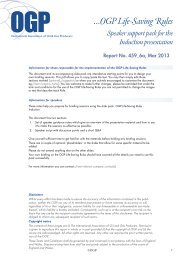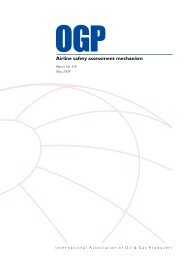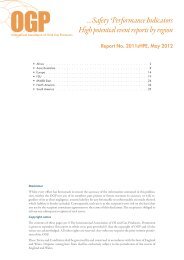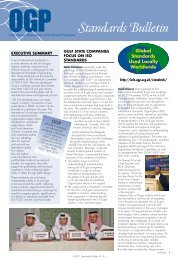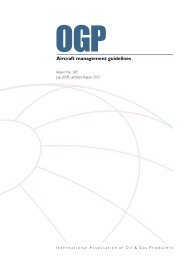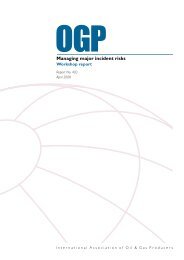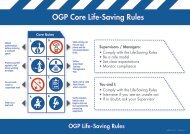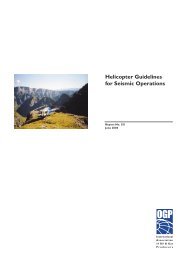Helicopter guidelines for land seismic & helirig operations - OGP
Helicopter guidelines for land seismic & helirig operations - OGP
Helicopter guidelines for land seismic & helirig operations - OGP
Create successful ePaper yourself
Turn your PDF publications into a flip-book with our unique Google optimized e-Paper software.
<strong>Helicopter</strong> <strong>guidelines</strong> <strong>for</strong> <strong>land</strong> <strong>seismic</strong> & <strong>helirig</strong> <strong>operations</strong><br />
6 Base camp ground infrastructure and equipment<br />
requirements<br />
6.1 Location<br />
6.1.1 Where possible, the siting of a base camp should allow <strong>for</strong> the bulk delivery of large<br />
quantities of aviation fuel; sites located adjacent to arterial communications such as<br />
roads, or rivers navigable by flat-bottomed barges, are ideal.<br />
6.1.2 The alignment of <strong>land</strong>ing strips and aircraft operating areas must take account of the<br />
prevailing wind and the need to avoid over-flying populated areas during take-off and<br />
approach to <strong>land</strong>ing. Government or mission airstrips can be used to good effect;<br />
6.1.3 Local topography affects the aviation aspects of base camp selection and <strong>for</strong> this<br />
reason the following locations should be avoided:<br />
1. Valley and bowl locations, which present obstacles on take-off and unacceptably<br />
steep approaches. Early morning mist is slow to clear from such sites in jungle<br />
areas and may, especially in mountainous areas, give rise to excessive turbulence.<br />
2. Un-grassed areas that are likely to give rise to excessive dust during dry periods.<br />
3. Sites close to population centres, which could cause undue nuisance to local<br />
population and/or risk exposure.<br />
4. Sites which cannot easily and economically be made secure. The local security<br />
situation should be fully assessed. While this aspect affects the entire <strong>seismic</strong><br />
operation, aircraft and Flight crew are particularly sensitive to threats such as<br />
sabotage and hijacking and tampering with fuel supplies.<br />
5. Low lying areas susceptible to flooding which can affect aviation fuel storage,<br />
aviation fuel quality control and aircraft maintenance. Mosquito nuisance may<br />
affect evening and night maintenance.<br />
6. Power lines and other high obstacles such as towers, are a particular hazard,<br />
especially near the heavily utilised base camp helipad. There<strong>for</strong>e and depending<br />
on the proximity of these cables, the position of the base camp helipad must be<br />
considered with regard to approach and departure routes. Where power lines or<br />
high obstacles are present in any <strong>seismic</strong> area the following is recommended:<br />
a. All power lines and other high obstacles such as towers etc. (or at least those<br />
within 500m of any helipad) should be clearly marked on hazards map.<br />
b. Every pilot joining an operation <strong>for</strong> the first time should be fully briefed and<br />
area airborne familiarisation checked on the position of overhead cables and<br />
other hazards, with pilots’ topographical maps marked accordingly. All maps<br />
should be checked <strong>for</strong> validity on subsequent periods of duty.<br />
c. Where appropriate and in particular <strong>for</strong> power lines/high obstacles close<br />
to the base camp, ef<strong>for</strong>ts should be made to get these marked (marker balls,<br />
flashing lights) by the owner of these installations.<br />
6.2 General layout<br />
6.2.1 A prime requirement is that pedestrian and vehicular traffic should be separated from<br />
helicopters when they are parked, being refueled, maneuvered or operated. <strong>Helicopter</strong><br />
<strong>land</strong>ing, parking and refueling areas should be declared “Restricted Area”, with<br />
authorized access only. Warning notices, advising personnel not to proceed beyond<br />
appropriate points should be prominently displayed and, if necessary, a traffic-flow<br />
control system introduced to halt vehicles during helicopter arrivals and departures.<br />
6.2.2 An area adjacent to the Party Chief or flight planner office should be allocated to a<br />
logistics office/radio room.<br />
© <strong>OGP</strong><br />
17



